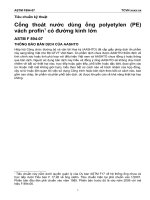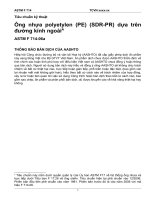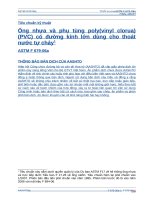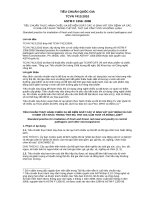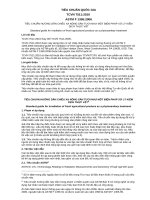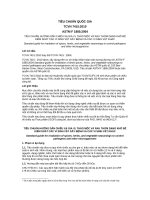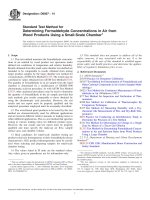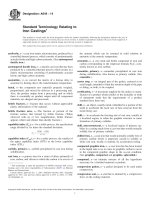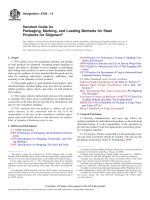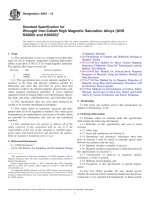Astm f 493 14
Bạn đang xem bản rút gọn của tài liệu. Xem và tải ngay bản đầy đủ của tài liệu tại đây (95.8 KB, 6 trang )
Designation: F493 − 14
Standard Specification for
Solvent Cements for Chlorinated Poly(Vinyl Chloride)
(CPVC) Plastic Pipe and Fittings1
This standard is issued under the fixed designation F493; the number immediately following the designation indicates the year of original
adoption or, in the case of revision, the year of last revision. A number in parentheses indicates the year of last reapproval. A superscript
epsilon (´) indicates an editorial change since the last revision or reapproval.
This standard has been approved for use by agencies of the U.S. Department of Defense.
Under Constant Internal Pressure
D1599 Test Method for Resistance to Short-Time Hydraulic
Pressure of Plastic Pipe, Tubing, and Fittings
D1784 Specification for Rigid Poly(Vinyl Chloride) (PVC)
Compounds and Chlorinated Poly(Vinyl Chloride)
(CPVC) Compounds
D2846/D2846M Specification for Chlorinated Poly(Vinyl
Chloride) (CPVC) Plastic Hot- and Cold-Water Distribution Systems
F402 Practice for Safe Handling of Solvent Cements,
Primers, and Cleaners Used for Joining Thermoplastic
Pipe and Fittings
F412 Terminology Relating to Plastic Piping Systems
F439 Specification for Chlorinated Poly (Vinyl Chloride)
(CPVC) Plastic Pipe Fittings, Schedule 80
2.2 NSF Standards:
Standard No. 14 for Plastic Piping Components and Related
Materials3
Standard No. 61 for Drinking Water Systems Components—
Health Effects3
1. Scope*
1.1 This specification provides requirements for chlorinated
poly(vinyl chloride) (CPVC) solvent cements to be used in
joining chlorinated poly(vinyl chloride) pipe, tubing, and
socket-type fittings.
1.2 CPVC solvent cements are used with CPVC 41 chlorinated poly(vinyl chloride) pipe, tubing, and fittings, which
meet Class 23447 as defined in Specification D1784.
1.3 A recommended procedure for joining CPVC pipe and
fittings is given in Appendix X1.
1.4 The text of this specification references notes, footnotes,
and appendixes which provide explanatory material. These
notes and footnotes (excluding those in tables and figures) shall
not be considered as requirements of the specification.
1.5 The values stated in inch-pound units are to be regarded
as standard. The values given in parentheses are mathematical
conversions to SI units that are provided for information only
and are not considered standard.
1.6 The following safety hazards caveat pertains only to the
test methods portion, Section 6, of this specification: This
standard does not purport to address all of the safety concerns,
if any, associated with its use. It is the responsibility of the user
of this standard to establish appropriate safety and health
practices and determine the applicability of regulatory limitations prior to use.
3. Terminology
3.1 Definitions—The definitions in this specification are in
accordance with Terminology F412.
4. General Requirements
4.1 The solvent cement shall be a solution of the base CPVC
resin used to make Class 23447, chlorinated poly(vinyl chloride) molding or extrusion compound as defined in Specification D1784.
2. Referenced Documents
2.1 ASTM Standards:2
D1084 Test Methods for Viscosity of Adhesives
D1598 Test Method for Time-to-Failure of Plastic Pipe
4.2 When rework material is used, the manufacturer shall
use only his own clean rework material that is compatible with
virgin material and produces a cement that meets the requirements of this specification.
1
This specification is under the jurisdiction of ASTM Committee F17 on Plastic
Piping Systems and is the direct responsibility of Subcommittee F17.20 on Joining.
Current edition approved Nov. 1, 2014. Published December 2014. Originally
approved in 1977. Last previous edition approved in 2010 as F493 – 10. DOI:
10.1520/F0493-14.
2
For referenced ASTM standards, visit the ASTM website, www.astm.org, or
contact ASTM Customer Service at For Annual Book of ASTM
Standards volume information, refer to the standard’s Document Summary page on
the ASTM website.
4.3 The cement shall be free-flowing and shall not contain
lumps, undissolved resin, or any foreign matter that will
adversely affect the ultimate joint strength or chemical resistance of the cement.
3
Available from NSF International, P.O. Box 130140, 789 N. Dixboro Rd., Ann
Arbor, MI 48113-0140, .
*A Summary of Changes section appears at the end of this standard
Copyright © ASTM International, 100 Barr Harbor Drive, PO Box C700, West Conshohocken, PA 19428-2959. United States
1
F493 − 14
TABLE 2 Minimum Hydrostatic Sustained Pressure Requirements
for Nominal 1⁄2 in. CPVC Solvent-Cemented Joints Tested in
Water or Air External Environment at 180 ± 3.6°F (82 ± 2°C)
4.4 The cement shall show no gelation or stratification that
cannot be removed by stirring.
4.5 When inert fillers and colorants are added, the resulting
cement shall meet all requirements of this specification.
Test
Condition
A
NOTE 1—It is recommended that CPVC solvent cement be orange in
color to facilitate identification and minimize unintentional use of other
cements that may fail at elevated service temperatures.
6 min
B
4.6 The particular solvent system to be used in the formulation of this solvent cement is not specified, since it is
recognized that a number of adequate solvent systems for
CPVC exist. Solvent systems consisting of blends of tetrahydrofuran and cyclohexanone have been found to make cements
that meet the requirements of this specification.
4h
Hydrostatic Test Pressure, psi (MPa)
Water Bath
Air Bath
521
551
(3.59)
(3.80)
364
403
(2.51)
(2.78)
6.1.1.4 Desiccator, and
6.1.1.5 Centrifuge.
6.1.2 Procedure—Stir the sample thoroughly with a spatula
before weighing (Note 3). Weigh 0.106 6 0.123 oz (3.0 6 0.5
g) of the sample to the nearest 3.53 × 10-5 oz (1 mg) into a tared
ointment tin with cover. Place the tin into the vacuum oven
(Note 4), and heat at 248°F (120°C) for 45 to 60 min. Discard
specimens left in for more than 60 min. The vacuum must be
continually in operation to draw off flammable solvents and
shall be maintained below 0.29 psi (15 mm Hg) pressure.
Remove the tin from the oven and cap immediately. Place in a
desiccator until cooled to room temperature. Weigh the tin and
dried sample to the nearest 3.53 × 10-5 oz (1 mg).
5. Detail Requirements
5.1 Resin Content—The CPVC resin content shall be 10 %
minimum when tested in accordance with 6.1.
5.2 Dissolution—The cement shall be capable of dissolving
an additional 3 % by weight of CPVC 41 compound (either
powder or granular) or equivalent CPVC resin at 73 6 3.6°F
(23 6 2°C) without evidence of gelation.
5.3 Viscosity—Cements are classified as regular-, medium-,
or heavy-bodied types, based on their minimum viscosity when
tested in accordance with 6.2.
5.3.1 Regular-bodied cements shall have a minimum viscosity of 90 cP (90 MPa·s).
5.3.2 Medium-bodied cements shall have a minimum viscosity of 500 cP (500 MPa·s).
5.3.3 Heavy-bodied cements shall have a minimum viscosity of 1600 cP (1600 MPa·s).
NOTE 3—This material is usually nonhomogeneous and shall be
thoroughly stirred before weighing. The weighing shall also be accomplished quickly to avoid loss of solvent by evaporation.
NOTE 4—The use of a vacuum oven is mandatory for drying the
specimen, because this oven has neither an exposed heating surface nor an
open flame, thus avoiding the danger of flashing. The oven also provides
an open vacuum to exhaust solvent fumes.
6.1.3 Inert Filler Determination—Dissolve most of the
dried sample by adding 0.507 oz (15 mL) of tetrahydrofuran
(THF) to the sample in the ointment tin and stirring with a glass
rod for 15 min. Collect the liquid decanted from this step, plus
the liquid from the next two steps. Dissolve the remainder with
a second addition of 0.507 oz (15 mL) of THF, followed by a
third addition of 0.17 oz (5 mL) of THF to rinse the ointment
tin. Centrifuge the entire volume at 20 000 rpm for 15 min.
Discard the supernatant liquid. Add 0.507 oz (15 mL) of THF
to the tube, mix thoroughly, and transfer the tube contents to
the ointment tin. Use 6.76 ×10 -2 (2 mL) more of THF to wash
down the tube, and pour into the ointment tin. Evaporate off the
THF in the vacuum oven at 248°F (120°C) for 45 min. Cool in
desiccator, weigh the tin to the nearest 3.53 × 10-5 oz (1 mg),
and determine the weight of inert filler present in the cement.
6.1.4 Calculation—Calculate the percentage of CPVC resin
as follows:
NOTE 2—Refer to Appendix X2 for guidelines in selecting CPVC
solvent cements for joining different pipe sizes.
5.4 Shelf Stability—The cement, in the container in which it
is supplied, shall show no gelation or stratification that cannot
be removed by stirring after aging 30 days at 120°F (49°C).
5.5 Hydrostatic Burst Strength—Joints made using 2-in. (63
mm) CPVC piping and this cement shall meet the requirements
of Table 1 when tested in accordance with 6.3.
5.6 Hydrostatic Sustained Pressure Strength—Joints made
using 1⁄2-in. CPVC tubing and this cement shall meet the
requirements of Table 2 when tested in accordance with 6.4.
6. Test Methods
6.1 Solid Contents:
6.1.1 Apparatus:
6.1.1.1 Ointment Tins, Style No. 12, 1-oz (30-mL), all
metal,
6.1.1.2 Analytical Balance,
6.1.1.3 Vacuum Oven,
Resin, % 5 ~ B 2 A 2 D ! / ~ C 2 A ! 3 100
where:
A = weight
B = weight
C = weight
D = weight
TABLE 1 Minimum Hydrostatic Burst Strength Requirements for
Nominal 2 in. CPVC Solvent-Cemented Joints After 2 h Drying at
Test Temperature
Temperature, °F (°C)
73 (23)
180 (82)
Test Duration
of
of
of
of
ointment tin,
tin and specimen after drying,
tin and specimen before drying, and
inert filler, if present.
NOTE 5—Other methods for determination of resin and inert filler
content may be used provided that the results of the alternative method are
as accurate and consistent as the above method.
Burst Pressure, psi (MPa)
400 (2.76)
200 (1.38)
6.2 Viscosity:
6.2.1 Measure the viscosity in accordance with Method B of
Test Methods D1084, except that conditioning to temperature
2
F493 − 14
for 30 6 5 min if using a water bath or 120 6 5 min if using
an air bath, then test immediately.
6.4.7 Attach to pressure source and place on test at 180°F
(82°C) and the proper hydrostatic pressure 610 psi (670 kPa)
as specified in Table 2. Increase the internal pressure at a
constant rate to reach the test pressure in 15 to 20 s.
6.4.8 Leakage or separation at any of the joints tested at less
than the test duration time specified in Table 2 for both test
conditions A and B shall constitute failure in this test.
equilibrium only is required. For qualification purposes, use a
Model RVF viscometer, a speed of 10 r/min, and the spindle
that, by trial, gives the closest reading to center range of scale
for the cement being tested. Other speeds may be used for
quality control purposes.
6.3 Hydrostatic Burst Strength:
6.3.1 Test in accordance with Test Method D1599, except as
herein specified.
6.3.2 Prepare a test assembly containing at least six nominal
2-in. (63 mm) solvent-cemented joints using CPVC 41 SDR 11
pipe and fittings meeting the requirements of Specification
D2846/D2846M. Cut the pipe into suitable lengths. The socket
depth of the fittings shall be 11⁄2 to 19⁄16 in. (38.1 to 38.50 mm)
(Schedule 80 in accordance with Specification F439).
6.3.3 The dimensions of the pipe and fitting socket shall be
such that the pipe will enter the socket from one third to two
thirds of the full socket depth dry when assembled by hand.
6.3.4 Cement the joints in accordance with the recommended solvent cementing procedure given in Appendix X1
except for X1.7.
6.3.5 Attach suitable end closures and fill the test assembly
with water, purging all air, and condition in water or air at the
test temperature for 120 6 5 min, then test immediately.
6.3.6 Increase the internal pressure at a constant rate so as to
reach the minimum burst requirement in 60 to 70 s.
6.3.7 Leakage or separation at any of the joints tested at less
than the minimum hydrostatic burst strength requirements
specified in Table 1 shall constitute failure in this test.
7. Retest and Rejection
7.1 If the results of any test(s) do not meet the requirements
of this specification, the test(s) shall be conducted again only
by agreement between the purchaser and the seller. Under such
agreement, minimum requirements shall not be lowered, nor
tests omitted, substituted, changed, or modified, nor shall
specification limits be changed. If upon retest, failure occurs,
the quantity of product represented by the test(s) does not meet
the requirements of this specification.
8. Report
8.1 Report the following information:
8.1.1 Name of cement manufacturer,
8.1.2 Lot number or sample identification,
8.1.3 Resin content, %,
8.1.4 Dissolution, pass or fail,
8.1.5 Viscosity,
8.1.6 Shelf stability, pass or fail,
8.1.7 Hydrostatic burst strength, and
8.1.8 Hydrostatic sustained pressure strength, test duration
time.
6.4 Hydrostatic Sustained Pressure Strength:
6.4.1 Test in accordance with Test Method D1598, except as
herein specified.
6.4.2 Prepare a test assembly containing six nominal 1⁄2in.(15.24 cm) solvent-cemented joints using CPVC 41 SDR 11
tubing and fittings meeting the requirements of Specification
D2846/D2846M. Cut the tubing into 6-in. lengths and use two
couplings and two male adapters.
6.4.3 The dimensions of the tubing and fitting socket shall
be such that the tubing will enter the socket from one third to
two thirds of the full socket depth dry when assembled by
hand.
6.4.4 Prepare the pipe and fittings for joining in accordance
with X1.1, X1.2 and X1.3 of the recommended solvent
cementing procedure given in Appendix X1. Do not apply
cleaner or primer and do not sand. Apply a very light coat of
CPVC cement to the socket and a heavy coat to the pipe end.
Immediately insert the pipe into the fitting with a slight
twisting motion until it bottoms in the socket. Hold the joint
together until the cement has set. Remove any excess cement
from the joint.
9. Certification
9.1 When specified in the purchase order, the manufacturer
shall certify to the purchaser or to his nominee that the products
in the specified lots meet all the requirements of this specification and when requested shall include a copy of the manufacturer’s routine quality control tests to document that the
specification requirements have been met. Each certification so
furnished shall be signed by an authorized agent of the
manufacturer.
10. Container Labeling and Marking
10.1 Container labeling of CPVC solvent cement shall
include the following:
10.1.1 Manufacturer’s or seller’s name and address and
tradename or trademark, or both.
10.1.2 This designation: “ASTM F493.”
10.1.3 Function of material (Cement for CPVC Pipe).
10.1.4 Cement type according to viscosity as shown in
detail requirement of 5.3.
10.1.5 Pipe sizes, SDR’s, and schedules for which the
cement is recommended.
10.1.6 Procedure or instructions for application and use.
10.1.7 Lot number of batch on container.
10.1.8 Solvent cement intended for use on potable water
systems should be evaluated and certified as safe for this
purpose by a testing agency acceptable to the local health
authority.
NOTE 6—The purpose of the test method is to evaluate the performance
of the CPVC cement alone, and therefore applying cleaner or primer or
sanding, in accordance with X1.4, is not required for this purpose.
6.4.5 Dry the solvent-cemented joints in air at 73.4 6 3.6°F
(23 6 2°C) for 336 6 2 hr. Then dry the solvent-cememted
joints at 180 6 3.5°F (82 6 2°C) for 48 6 2 hr.
6.4.6 Attach suitable end closures and fill the test assembly
with water, purging all air, and condition at the test temperature
3
F493 − 14
NOTE 7— The evaluation should be in accordance with requirements for
chemical extraction, taste, and odor, that are no less restrictive than those
included in NSF Standard No. 14. The seal or mark of the laboratory
making the evaluation should be included on the container.
Maintain ventilation to reduce fire hazard and to minimize
breathing of solvent vapors. Avoid contact of cement with skin
and eyes.
10.1.9 End use application (Example: potable water).
10.1.10 All warnings and cautions necessitated by:
10.1.10.1 Ingredients,
10.1.10.2 Handling and distribution of the product,
10.1.10.3 Intended use, and
10.1.10.4 Requirements of Law (such as the Federal Hazardous Substance Act).
These are intended to warn those who handle or use the product
against potential hazards, such as flammability, toxicity, etc.
11.2 Refer to Practice F402 for information on safe handling
of solvent cements.
12. Quality Assurance
12.1 When the product is marked with this designation,
F493, the manufacturer affirms that the product was
manufactured, inspected, sampled, and tested in accordance
with this specification and has been found to meet the
requirements of this specification.
NOTE 8—It is recommended that the color of the cement also be
indicated on the label.
13. Keywords
11. Safe Handling of Solvent Cement
13.1 cement; CPVC; solvent cement
11.1 Solvent cements for plastic pipe are made from flammable liquids. Keep them away from all sources of ignition.
SUPPLEMENTARY REQUIREMENTS
This requirement applies whenever a regulatory authority or user calls for the product to be used to
convey or to be in contact with potable water.
S1. Potable Water Requirement—Products intended for
contact with potable water shall be evaluated, tested, and
certified for conformance with ANSI/NSF Standard No. 61 or
the the health effects portion of NSF Standard No. 14 by an
acceptable certifying organization when required by the regulatory authority having jurisdiction.
APPENDIXES
(Nonmandatory Information)
X1. RECOMMENDED PROCEDURE FOR MAKING SOLVENT-CEMENTED JOINTS WITH CHLORINATED POLY(VINYL
CHLORIDE) (CPVC) PIPE AND FITTINGS
X1.1 Cutting—Cut the pipe square, using a tubing cutter or
a fine-toothed hand saw and mitre box. Tubing cutters with thin
cutting wheels designed specially for plastic are recommended.
impervious to the solvents, to prevent skin contact.
X1.5 Cement Application—Apply a heavy thick coat of
CPVC cement to the pipe end and a light thin coat to the inside
of the fitting socket. If cement dries on either surface before
joining, apply another coat.
X1.2 Burrs—Remove all ridges caused by tube cutter and
burrs with sandpaper or knife.
X1.3 Pipe Fit—Check dry fit of pipe in the fitting to ensure
that there is an interference fit. The dry pipe or tubing should
enter the fitting socket from one third to two thirds of the full
socket depth when assembled by hand.
X1.6 Joining—Immediately insert the pipe into the fitting
with a slight twisting motion until it bottoms in the socket.
Quickly align fitting direction. Hold the joint together momentarily until cement has set. Remove excess cement from the
joint.
X1.4 Cleaning—Clean the pipe end and fitting socket. Wipe
away dust, moisture, and foreign materials with a clean dry
cloth or use a cleaner, or primer, or sand with fine abrasive
paper. Cleaner or primer should be that recommended by the
cement manufacturer for use with CPVC plastic pipe. Apply
the cleaner or primer with an applicator or wear gloves
X1.7 Handling—The joint may be handled immediately
with care. Avoid rough handling for 1 h. The joint normally
may be pressure tested after 16 h.
NOTE X1.1—Additional information concerning CPVC piping systems
and installation practices may be found in Specification D2846/D2846M.
4
F493 − 14
X2. GUIDE FOR CPVC SOLVENT CEMENT SELECTION
X2.1 It is recommended that only regular-bodied cements
be used to join CPVC tubing sizes of Specification D2846/
D2846M, since medium-bodied and heavy-bodied cements are
generally formulated for larger pipe sizes and have longer open
or drying times than regular-bodied cements.
based on minimum viscosity and minimum wet-film thickness.
Solvent cement manufacturer’s recommendations should be
followed. The guidelines shown in Table X2.1 and Table X2.2
are general ones, and solvent cement properties may vary
considerably among manufacturers.
X2.2 The successful joining of CPVC pipe and fittings,
larger than 2 in. (63mm), and noninterference-type joints
requires the use of solvent cements that have higher-gap filling
properties than the minimum-viscosity 90 cP (90 MPa·s)
cements permitted in this specification. The ability of a solvent
cement to fill a gap in a pipe joint can be determined by
considering its viscosity and wet-film thickness (Note X2.1). A
guide to the proper selection of a solvent cement for the various
pipe sizes is given in Table X2.1 and Table X2.2, where
cements are classified into three types (for purposes of identification) as regular-bodied, medium-bodied, or heavy-bodied,
NOTE X2.1—The wet-film thickness of a solvent cement can be
measured by using a Nordson Wet Film Thickness Gage or equivalent,
available from Nordson Corp., Amherst, OH 44001, as Nordson No.
79-0015. To use this gage, dip a short length of 1-in. pipe vertically into
the cement at a temperature of approximately 23°C (73°F) to a depth of
1.5 to 2 in. (40 to 50 mm) for a period of 15 s. Remove the pipe from the
cement and hold the pipe horizontally for 45 s. Measure the wet-film
thickness on the top surfaces of the pipe with the end of the gage about 1⁄4
in. (10 mm) from the end of the pipe. With a little care and experience, the
wet cement layer can be readily measured to 60.002 in. (60.05 mm).
NOTE X2.2—The cement manufacturer’s recommendations should be
followed in selecting the proper cement for joining Schedule 80 pipe sizes
above 6 in.
TABLE X2.1 CPVC Cements for Tubing and Schedule 40 Interference Fit
Pipe Size Range, in.
Cement Type
⁄ to 2
⁄ to 2
1
2 ⁄2 to 6
6 to 12
regular-bodied
regular-bodied
medium-bodied
heavy-bodied
38
18
Minimum Viscosity
cP
(MPa·s)
90
(90)
Tubing
Minimum Wet Film
in.
(mm)
0.006
(0.15)
Schedule 40 Interference Fit
Minimum Viscosity
Minimum Wet Film
cP
(MPa·s)
in.
(mm)
90
500
1600
(90)
(500)
(1600)
0.006
0.012
0.024
TABLE X2.2 CPVC Cements for Schedule 80 and
Noninterference Fits (Note X2.2)
Minimum Viscosity Minimum Wet Film Thickness
Pipe Size
Cement Type
Range, in.
cP
(MPa·s)
in.
(mm)
1⁄8 to 11⁄4
medium-bodied
500
(500)
0.012
(0.30)
heavy-bodied
1600
(1600)
0.024
(0.60)
11⁄2 to 6
SUMMARY OF CHANGES
Committee F17 has identified the location of selected changes to this standard since the last issue (F493–10)
that may impact the use of this standard.
(1) Table 1 was revised.
5
(0.15)
(0.30)
(0.60)
F493 − 14
ASTM International takes no position respecting the validity of any patent rights asserted in connection with any item mentioned
in this standard. Users of this standard are expressly advised that determination of the validity of any such patent rights, and the risk
of infringement of such rights, are entirely their own responsibility.
This standard is subject to revision at any time by the responsible technical committee and must be reviewed every five years and
if not revised, either reapproved or withdrawn. Your comments are invited either for revision of this standard or for additional standards
and should be addressed to ASTM International Headquarters. Your comments will receive careful consideration at a meeting of the
responsible technical committee, which you may attend. If you feel that your comments have not received a fair hearing you should
make your views known to the ASTM Committee on Standards, at the address shown below.
This standard is copyrighted by ASTM International, 100 Barr Harbor Drive, PO Box C700, West Conshohocken, PA 19428-2959,
United States. Individual reprints (single or multiple copies) of this standard may be obtained by contacting ASTM at the above
address or at 610-832-9585 (phone), 610-832-9555 (fax), or (e-mail); or through the ASTM website
(www.astm.org). Permission rights to photocopy the standard may also be secured from the Copyright Clearance Center, 222
Rosewood Drive, Danvers, MA 01923, Tel: (978) 646-2600; />
6
